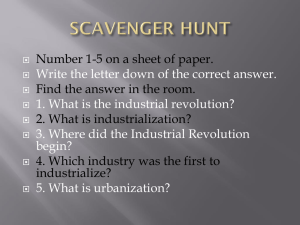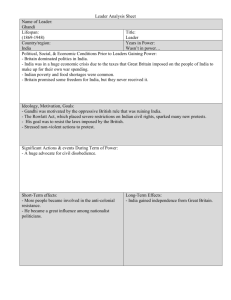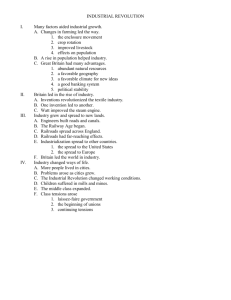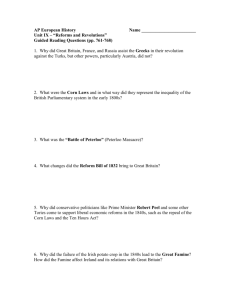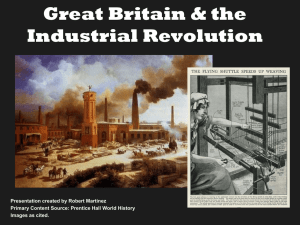20-2ppupload
advertisement
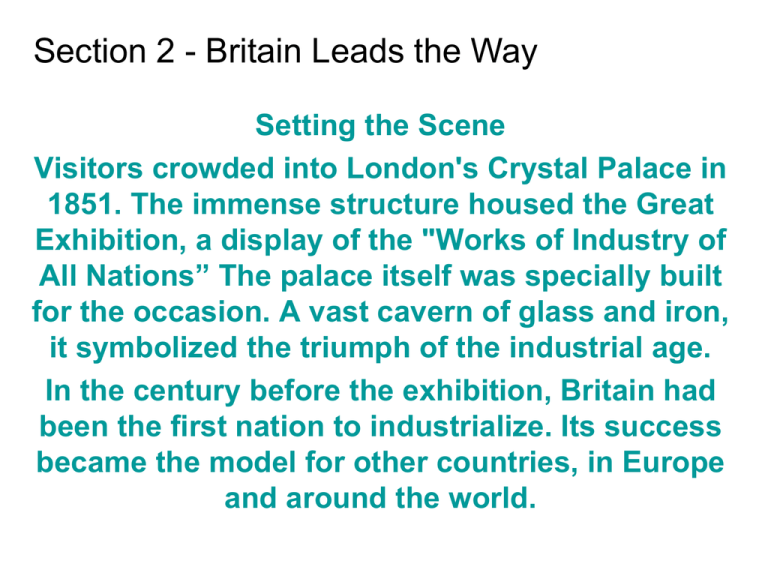
Section 2 - Britain Leads the Way Setting the Scene Visitors crowded into London's Crystal Palace in 1851. The immense structure housed the Great Exhibition, a display of the "Works of Industry of All Nations” The palace itself was specially built for the occasion. A vast cavern of glass and iron, it symbolized the triumph of the industrial age. In the century before the exhibition, Britain had been the first nation to industrialize. Its success became the model for other countries, in Europe and around the world. I. Why Britain? A. Resources - Britain had coal to power steam engines, iron to build machines, and a large labor force The Crystal Palace, built in 1856, was a remarkable building with 293,655 panes of glass, 330 huge iron columns, and 24 miles of gutters. I. Why Britain? B. New Technology - Skilled mechanics and technology paved the way for industrialization I. Why Britain? C. Economic Conditions - Economic prosperity made consumer goods affordable to members of every social class I. Why Britain? D. Political and Social Conditions - Britain had a stable government that supported economic growth Changes in the Textile Industry The Industrial Revolution first took hold in Britain's largest industry - textiles Changes in the Textile Industry Cotton cloth imported from India had become popular and British merchants organized a cloth industry at home II. Changes in the Textile Industry They developed the “putting-out” system cotton was distributed to peasants who spun it into thread and wove the thread into cloth Major Inventions New inventions included John Kay's flying shuttle, James Hargreaves’ spinning jenny and Richard Arkwright’s waterframe The flying shuttle a single weaver, using one hand, could operate the shuttle on the loom The "spinning jenny" a device which allowed one person to spin up to 80 threads at once Richard Arkwright created the "water frame" to produce yarn faster The First Factories The machines couldn’t be operated at home so manufacturers built the first factories Revolution in Transportation As production increased, faster and cheaper methods of moving goods was needed Turnpikes, canals, stronger bridges and upgraded harbors helped expand domestic and overseas trade A. On Land The great revolution in transportation was the steam locomotive. By 1870, rail lines crisscrossed Britain, Europe, and North America The Rocket B. On Sea In 1807, American Robert Fulton used Watt's steam engine to improve shipping B. On Sea By the late 1800s, steam-powered freighters were carrying 10 to 20 times the cargo of older wooden ships An Early Steamship, the Great Britain, 1845 Looking Ahead As the Industrial Revolution got under way, it triggered a chain reaction. In response to growing demand, inventors developed machines that could produce large quantities of goods more efficiently. As the supply of goods increased, prices fell. Lower prices made goods more affordable and thus created more consumers who further fed the demand for goods. The Industrial Revolution affected not only how goods were made but also how people lived. It brought a tidal wave of economic & social changes that swept the industrializing nations of the world.


